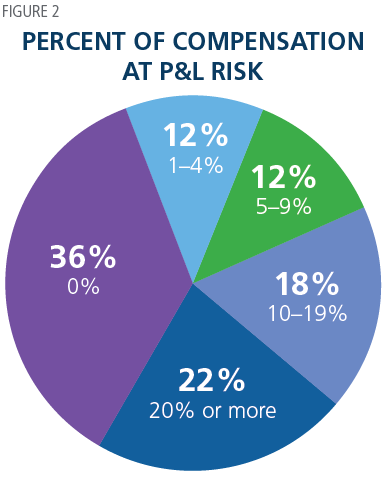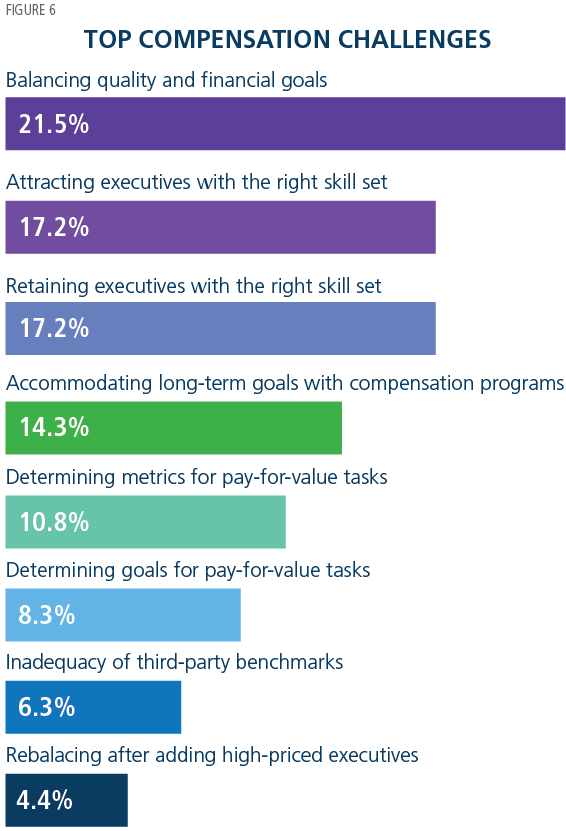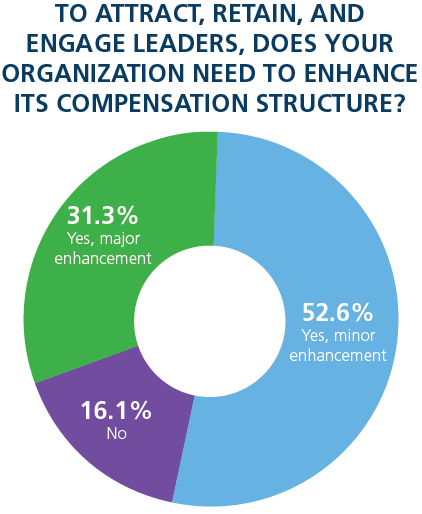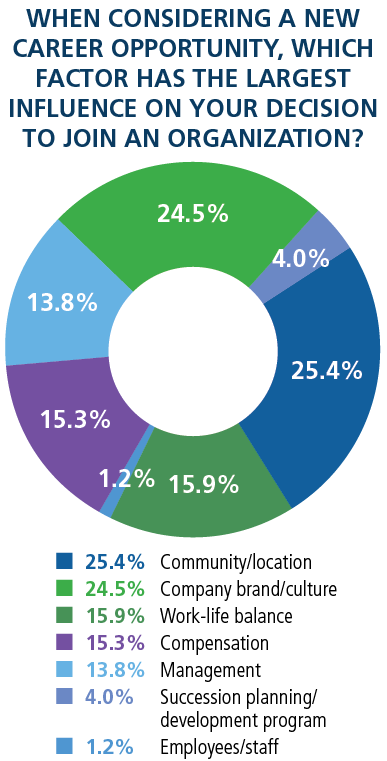B.E. Smith Team | December 30, 2018
INTELLIGENCE REPORT: THE VALUE OF COMPENSATION IN TODAY’S HEALTHCARE LANDSCAPE
 B.E. Smith has just completed the annual Executive Compensation Intelligence Report. Once again, it offers a wide-ranging look at a subject of high interest and major impact on many aspects of organizational strategy. This white paper spotlights key findings and actionable insights from 350 surveyed leaders.
B.E. Smith has just completed the annual Executive Compensation Intelligence Report. Once again, it offers a wide-ranging look at a subject of high interest and major impact on many aspects of organizational strategy. This white paper spotlights key findings and actionable insights from 350 surveyed leaders.
ABOUT THE RESPONDENTS
The distribution of survey respondents displayed in Figure 1 shows well-balanced leadership participation, with especially strong representation from both C-suite and director levels. The mix within the C-suite was also healthy. Input was obtained from all key functions, and the substantial CEO/COO participation ensured top-level perspectives.
Hospitals and health systems together constituted 71% of the respondents, with 45% coming from health systems in what likely reflects the continuing trend to industry consolidation. In fact, the AHA pegs 58% of hospitals as now being part of some type of system structure. (1) The survey also achieved a notable response rate from another growing sector: outpatient, alternative, and post-acute sites. The institutional size data mirrored last year’s report, with 30% of organizations generating revenue north of $1 billion while 23% were under $100 million. The intervening ranges gathered nearly equal percentages, affirming the survey’s breadth.
COMPENSATION PROFILE
The survey’s starting point was to capture the respondents’ actual current executive compensation levels. At 69%, the largest segment indicated that combined cash, non-cash, and deferred compensation totaled between $100,000 and $299,000. Another 19% reported earning between $300,000 and $499,000, while 6% exceeded $500,000.

These figures align with external evidence on compensation for specific leadership positions. A comprehensive Modern Healthcare survey showed median total cash compensation for executives ranged from $236,000 (Operations) to $706,000 (CEOs). (2) On the clinical side, the same study cited CMO pay at $412,000 to $420,000, while a PayScale report placed CNO median salaries at $126,000 and total compensation ranging up to $207,000. (3)
COMPENSATION TRENDING
Echoing the previous annual survey, 45% of respondents said their compensation was higher than the prior year. The mean increase in base salary was just under 8%. However, healthcare organizations continue to maintain cost discipline in the face of margin pressures, evidenced by the 51% whose compensation was the same or lower than last year. The mean decrease was a hefty 20%. For comparison, Modern Healthcare reported that average total cash compensation increased 4.8% in 2018 across 39 executive positions. (4) Another interesting data point comes from the growing outpatient sector, where C-suite executives in larger medical groups realized total cash compensation increases up to 4.4% in 2017. CEOs garnered rises of 7.5% to 11.1%. (5)
Various recent surveys have shown pay growth in double digit ranges for newer executive roles in informatics, clinical leadership and other emerging areas. For example, Directors of Care Coordination in group practices experienced median increases of 14%. (6)
 AT-RISK INCENTIVES
AT-RISK INCENTIVES
The survey also provided a snapshot of the components of total executive compensation. There has been a clear recent trend to tie bonus pay to targets congruent with value-based reimbursement. Figure 2 displays the breakdown of such individual financial risk exposure. While a significant 36% still have no incentive, that figure declined from 43% last year. Correspondingly, those over 20% incentive compensation – a substantial level – rose 8 points. The trend toward P&L incentivization seems clear.
What objectives are being established to incentivize today’s leaders? Figure 3 ranks the most frequently mentioned. Many plans combine several of these goals. Margin, cash flow, and revenue growth targets loom large on the list. Hospital margins remain in the low- to mid-single digits, so this focus is understandable.

At the same time, the value-based care environment rewards balancing financial health with improved clinical outcomes, seen here in the strong showing for incentives connected to clinical performance and patient engagement. Population health management objectives are expected to grow from their current low base. The B.E. Smith Intelligence report earlier this year found 57% of organizations have a program in place or being implemented, and much emphasis is being placed on this promising movement.
Long-term performance incentives for growth, income, and quality/safety metrics are also taking hold. A leading compensation consultant places the adoption rate at 19% for all organizations and 59% for the ones above $5 billion in revenue. (7)
SATISFACTION WITH COMPENSATION
Given the numbers, it is helpful to observe how executives perceive their pay. The compensation survey revealed a noticeable year-over-year uptick from 46% to 57% in satisfaction with their organization’s program. Still, with 43% dissatisfied or neutral, more fine-tuning appears to be warranted.

What are the prevailing sentiments on non-salary compensation? Respondents’ most-valued components were:
- Benefits (36%)
- Performance Bonus (28%)
- Retirement Package (26%) – no doubt increasingly important as Baby Boomer leadership reaches retirement age.

STRATEGIC ALIGNMENT
OVERALL ALIGNMENT ISSUES
Compensation is a central aspect of talent management and vital to fostering strategic attainment. Evaluating alignment is therefore important. The good news is that this year’s survey saw a full 10-point gain in perception of alignment. Nevertheless, just over half of respondents see some level of misalignment, though most answered “slightly” rather than “seriously.” Organizations will need to remain vigilant in this area, since the velocity of change today makes the compensation/strategy match challenging.
SUPPORT FOR VALUE-BASED CARE
A predominant concern is designing compensation to further value-based care initiatives and goals. Alignment here is progressing but remains in early stages. Figure 4 indicates that half have not modified pay plans in service of these goals, but 21% have and an equal percentage plan to do so. This data exhibits a positive trend from last year.
Optimizing patient care and wellbeing while maintaining financial strength is a difficult balancing act. Organizations see compensation as a major lever to manage this effort. Figure 5 compares respondents’ assessments of the state of change in linking pay with financial and patient care objectives. These results show a 10-point increase relative to 2017 in the category of “change made in the right direction” for both areas. That trend was accompanied by a reduction in “change needed.” The “wrong direction” is fortunately relatively small, yet a reminder that compensation strategy must be addressed carefully. The “no change” responses could be more ambiguous, since the finding may be revealing what some industry analysts say is a set of organizations not yet fully prepared for new care models.

Drilling down further, the survey examined team-based incentives in light of the crucial need to foster collaboration. The top three were based on measures of:
 Patient engagement – 31%
Patient engagement – 31%- Clinical performance – 26%
- Population health management – 12%
These categories clearly link executives to initiatives that carry both strategic value and necessary reimbursement attainment. Devising team incentives is a multifaceted endeavor, and many seek outside consultation on best practices.
CHALLENGES IN OPTIMIZING COMPENSATION PROGRAMS
HR and senior leadership face several ongoing challenges as they shape compensation structures that further diverse objectives. Figure 6 ranks the feedback on the top three challenges currently encountered, led by “balancing quality of care and financial goals.” This response jumped ahead of last year’s leader, “retaining executives with the right skill set,” which continues to rate highly along with recruitment. Including the significant response for “determining metrics for pay-for-value,” the results again underscore the dominance of the value-based orientation in all aspects of healthcare.
 The various challenges cited are powerful and urgent enough that change appears to be needed. Indeed, an overwhelming 84% of survey respondents believed their compensation structure requires enhancement – 31% say the alteration must be a major rather than minor one.
The various challenges cited are powerful and urgent enough that change appears to be needed. Indeed, an overwhelming 84% of survey respondents believed their compensation structure requires enhancement – 31% say the alteration must be a major rather than minor one.
Healthcare is not alone in the struggle to optimize compensation plans. A cross-industry study by Willis Towers showed that many organizations find linking pay to performance and value problematic, with the top three barriers being:
- Limited budgets
- Executive/manager capabilities
- Limited range of factors on which to differentiate pay (8)
COMPENSATION’S ROLE IN RECRUITMENT AND RETENTION
Getting and keeping executives is a central mission of compensation strategy. In B.E. Smith’s earlier Intelligence Report, respondents named compensation/benefits as the most influential factor in both recruitment and retention of top talent, edging out organizational culture, a growing force. It is a demanding task recruiting leaders who possess a range of high-impact skills and ability to produce rapid results. The Executive Compensation survey probed the competencies most sought in leadership’s top echelon. The top four skills needed to succeed over the next five years were:
.png)
CEOs
- Optimizing results along the care continuum – 19%
- Physician alignment experience – 19%
- Cost containment abilities – 16%
- Mergers, acquisitions, and partnerships experience – 15%
OTHER C-SUITE EXECUTIVES
- Cost containment abilities – 19%
- Optimizing results along the care continuum – 18%
- Physician alignment experience – 14%
- Clinical experience – 10%
It is noteworthy that physician alignment increased from the 2017 results for both groups, and clinical experience made its first appearance in the top four. With organizations having invested in acquiring physician practices and with care coordination a growing need, fully integrating clinicians and ensuring they are fostering strategy are essential.
Compensation strategy must clearly address these requirements, especially in the incentive arena. That effort is complicated by today’s cost-constrained environment. While many question if organizations will continue to “pay up” for talent, B.E. Smith practice experience and leading analysts believe that they will. One states: “Nine out of 10 health systems err on the side of talent. There are high stakes for executive positions,” while another affirms that, “The right CEO, COO and CFO – especially those who work in physician alignment – are worth their weight in gold.” (9)

These sentiments are borne out by the survey. Up 12 points from 2017, 38% of respondents indicated that they have increased total compensation to recruit leaders. Upward pressure is likely to mount given the highly competitive labor market and the survey’s finding that 75% feel extremely or somewhat confident they can find a new position within a year if desired.
COMPENSATION IN CONTEXT
 The importance of compensation in healthcare executive talent management cannot be overstated. However, while it is a leading driver for recruitment and retention, compensation is often joined by the following high-ranking considerations:
The importance of compensation in healthcare executive talent management cannot be overstated. However, while it is a leading driver for recruitment and retention, compensation is often joined by the following high-ranking considerations:
- Work-Life Balance
- Institutional Brand and Culture
- Geographic Location
- Management and Colleagues
In fact, B.E. Smith research consistently shows compensation trailing these other influences when it comes to personal engagement – a vital organizational objective with clear implications for financial health. In the end, compensation should be viewed as the strong, essential foundation of a composite structure that incorporates many elements today’s leaders find attractive and compelling.
CONCLUSION
The 2018 Executive Compensation Intelligence Report offers a comprehensive look at the current pay landscape. The findings are a planning tool that can assist healthcare leaders in creating, evaluating and enhancing compensation strategies to promote current and long-term success.
REFERENCE
- American Hospital Association, Fast Facts on U.S. Hospitals, 2018.
- A. Kacik, “Steady Executive Pay Hikes Eclipse Cost-Containment Concerns,” Modern Healthcare, August 6, 2018.
- A. Vaidya, “8 Things to Know about CNO Salaries,” Becker’s Hospital Review, August 24, 2018.
- Kacik, Modern Healthcare.
- J. LaPointe, “Practices Upping Healthcare C-Suite Bonuses for Value-Based Care,” RevCycle Intelligence, April 27, 2018.
- Ibid.
- SullivanCotter, “2018 Manager and Executive Compensation in Hospitals and Health Systems Survey,” Infographic, 2018.
- Willis Towers Watson, Five Keys to Getting Compensation Right, 2018.
- Kacik, Modern Healthcare.
Read More